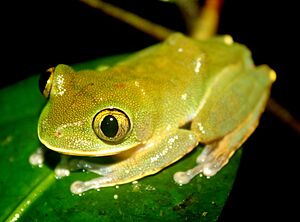Tai forest tree frog facts for kids
Quick facts for kids Tai forest tree frog |
|
|---|---|
 |
|
| Conservation status | |
| Scientific classification |
The Tai forest tree frog (Leptopelis occidentalis) is a type of frog that lives in trees. It belongs to the Arthroleptidae family of frogs. You can find this frog in countries like Liberia, the southern part of Ivory Coast, and Ghana. Some people think it might also live in Nigeria, but this is not certain. Those frogs might be a different kind, like Leptopelis boulengeri.
Contents
What Does the Tai Forest Tree Frog Look Like?
Male Tai forest tree frogs are about 36 to 46 millimeters long. This measurement is from their snout (nose) to their vent (bottom). Female frogs are larger, measuring about 49 to 72 millimeters long.
These frogs can have two main color patterns:
- Phase A: Their back is green. It can be plain green or have tiny white spots.
- Phase B: Their back is brown. It often has a darker pattern that looks like the letter "n." Sometimes, it has a triangle shape pointing towards its head.
Many of these frogs also have a small white spot just under their eye.
Sounds of the Tai Forest Tree Frog
Male Tai forest tree frogs often call out from high up in bushes, trees, or thick bamboo plants. They usually call in small groups. Their call is a soft "düt" sound. It has a unique quality that makes it easy to recognize. People also describe it as a typical "clack call" for Leptopelis frogs.
Where Does This Frog Live?
The Tai forest tree frog lives in dense, old forests, which are called primary forests. Sometimes, it can also be found in forests that have grown back after being cut down, known as secondary forests. These frogs live from areas near the sea up to about 200 meters (656 feet) above sea level.
This frog is an arboreal species, meaning it spends most of its life in trees. When it's time to lay eggs, they breed in small streams and temporary ponds.
Protecting the Tai Forest Tree Frog
The Tai forest tree frog is common in places where it has good habitat. However, its home is shrinking because of human activities. People are building more homes and farms, especially for palm oil and rubber. They are also cutting down trees for firewood and logging.
This frog lives in protected areas like the Taï National Park and Mont Sângbé National Park. Because its habitat is being lost, the International Union for Conservation of Nature (IUCN) has listed it as a near-threatened species. This means it could become endangered if its habitat continues to disappear.


